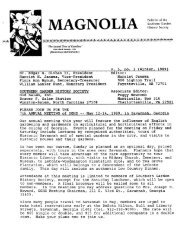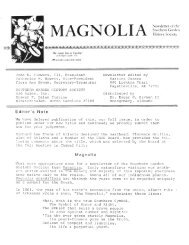Magnolia Newsletter Fall 04 - Southern Garden History Society
Magnolia Newsletter Fall 04 - Southern Garden History Society
Magnolia Newsletter Fall 04 - Southern Garden History Society
Create successful ePaper yourself
Turn your PDF publications into a flip-book with our unique Google optimized e-Paper software.
Adina de Zavala – …<br />
(continued from page 1)<br />
“De Zavala home at Buffalo Bayou” - De Zavala (Adina Emilia) Papers - Center for American <strong>History</strong> -<br />
The University of Texas at Austin CT 0603<br />
ambassador to France, and she probably remembered that her<br />
grandmother Emily reminisced about the beauty of the gardens<br />
there. Research on her part would have determined the ages of<br />
those roses, which actually pre-date the de Zavala’s stay in France.<br />
I think she simply wanted to mention her family’s colorful history<br />
in her article.<br />
In March 1834, de Zavala, accompanied by Emily, arrived in<br />
France as the Mexican ambassador to the Court of Louis Philippe.<br />
Holding court at the newly refurbished Castle of St. Cloud, one of<br />
his ancestral homes, Louis Philippe officially recognized de Zavala<br />
in April. Shortly after his arrival in France, de Zavala began to hear<br />
reports that Mexico’s president Santa Anna had become more<br />
centralist and dictatorial, turning away from the more republican<br />
policies de Zavala had supported. He sent Santa Anna a letter of<br />
resignation stating that he could not in good conscience represent a<br />
government with which he did not agree. He was ordered to stay at<br />
his post until his replacement arrived in France, and then he was to<br />
report to Mexico City. Lorenzo sent Emily and the children to<br />
New York in September of 1834, and it was eight months later<br />
before he arrived on May 4, 1835.<br />
At that time, de Zavala was essentially a man without a<br />
country, much less a home, but as Texas historian Dr. Margaret<br />
Henson points out, de Zavala was pragmatic. Knowing he had no<br />
future in Mexico, and well aware of what was going on in Texas,<br />
he decided that he would cast his lot there. He sent Lorenzo de<br />
Zavala, Jr., his son by his first wife, to Texas to locate a home for<br />
the family. Lorenzo, Sr. arrived in Texas in July 1835 and was soon<br />
involved with helping form the new government. In December<br />
1835, fourteen months after she left France, Emily and the<br />
younger children arrived with the household goods. Although it is<br />
probable that Emily visited gardens during her brief stay in France,<br />
there is no evidence that she brought roses from the Court of St.<br />
Cloud back to Texas.<br />
The frontier Texas house de Zavala bought was thought to<br />
have been a one-story log cabin that had been covered by boardand-batten<br />
siding. De Zavala felt the 177-acre tract at the junction<br />
of the San Jacinto River and Buffalo<br />
Bayou with easy access to Galveston Bay<br />
would be a commercially viable<br />
investment. He “liked the location and the<br />
neighborhood better than the heavily<br />
forested Brazos communities. Here the<br />
tree-lined banks gave way to open prairies<br />
and long vistas of open water leading to<br />
the Gulf.” 1 Adina remembers “the house<br />
in a level place on top of a fine hill,<br />
commanding a view in every direction.”<br />
One can only imagine how Emily felt<br />
about her new home after being at the<br />
Court of St. Cloud.<br />
Lorenzo de Zavala suffered from<br />
malaria during his first months in Texas.<br />
During January and February of 1836, he<br />
rested and worked on volume three of his<br />
history of Mexico. He felt well enough to<br />
supervise a thorough housecleaning with the<br />
aid of his three French speaking hired men and also had them<br />
prepare a large garden to sustain his family. He left home the last<br />
week in February to go to Washington-on-the-Brazos to attend the<br />
convention of delegates. 2<br />
Col. William Fairfax Gray (whose diary, From Virginia to<br />
Texas, described his journey to Houston and involvement with the<br />
Episcopalian Church) visited the de Zavala family in March 1836.<br />
He described the house as small, with one large room and three<br />
small bed closets, a porch and a kitchen. He commented that they<br />
had only moved into the house in the fall and have all the<br />
improvements to be made, but he was confident that when the<br />
“foreign taste and skill of the proprietor and his servants shall have<br />
time to make an impression on the face of nature, we may expect<br />
to see the desert smile.”<br />
Gray reported that Mrs.<br />
De Zavala had one Irish<br />
girl servant, one Black<br />
cook, and that there were<br />
several Frenchmen who<br />
did the outwork,<br />
“attending the horses,<br />
cows, garden, etc.” Gray<br />
described Emily as a “fine,<br />
beautiful woman, of tall,<br />
dignified person and<br />
ladylike manners, black<br />
eyes, twenty-seven years<br />
old…” 3<br />
A small, undated,<br />
black-and-white<br />
watercolor picture of the<br />
house in the Adina de<br />
Zavala collection at the<br />
Center for American<br />
<strong>History</strong>, University of<br />
Texas at Austin shows a<br />
“Adina De Zavala and the ‘Margil Vine’”<br />
De Zavala (Adina Emilia) Papers<br />
Center for American <strong>History</strong><br />
The University of Texas at Austin<br />
CT 06<strong>04</strong><br />
(continued on page 4)<br />
Vol. XIX, No. 3 <strong>Magnolia</strong> • <strong>Fall</strong> 20<strong>04</strong> 3
















